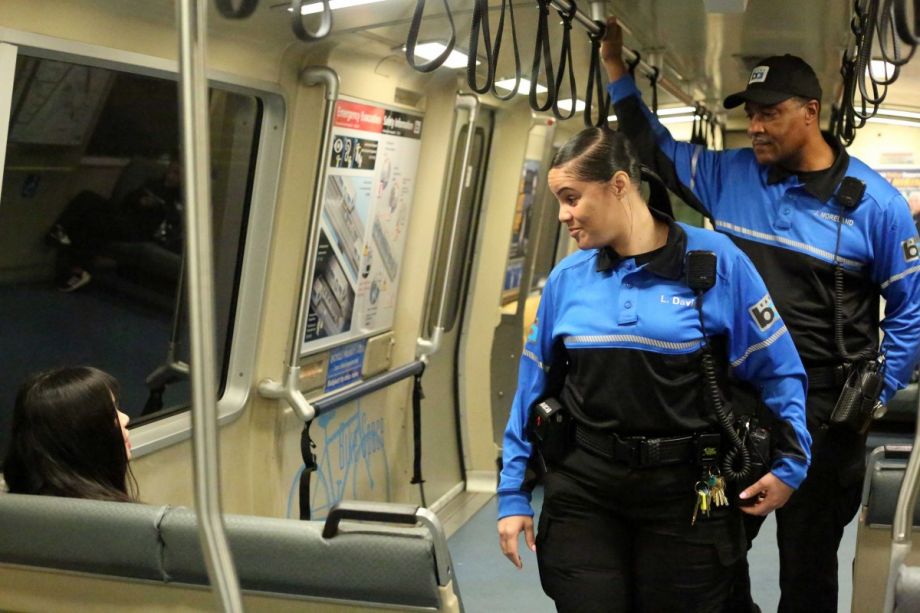Safety issues have long plagued transit agencies such as San Francisco’s Bay Area Rapid Transit District. But with the pandemic pushing safety concerns to new heights, BART is testing new safety measures that go beyond increasing police presence.
Last year, BART Police began to pilot its Transit Ambassadors program, using uniformed but unarmed personnel to respond to riders facing homelessness, mental health emergencies, drug overdoses and other crises. While the community ambassadors are still accompanied by police, the program is part of a shift in many urban transit agencies’ approach to passenger safety.
“The idea is to really reimagine safety and to meet the needs of all types of riders, but especially marginalized communities who are often not listened to, or or often aren’t given resources based on their needs,” says BART’s Chief Communications Officer Alicia Trost.
Although incidents of crime on BART for every million riders has been decreasing since the pandemic began, they remain higher compared to before it. BART saw 3.6 crimes per million riders in the first quarter of 2018, 31.85 crimes in the second quarter of 2020, and 7.21 crimes per million riders in the third quarter of 2021.
The same goes for quality of life violations, which involve people who harass passengers, panhandle, play loud music, or urinate or defecate in public. BART recorded 134.41 such violations per million passengers in the first quarter of 2018, which ballooned to 446.29 per million riders in the second quarter of 2020 and subsequently fell to 222.41 per million in the third quarter of 2021.
Meanwhile, BART ridership is not fully back to pre-pandemic levels. In June, weekday ridership continued to hover at one-third of pre-pandemic ridership, while weekend ridership generally hovered at around half. The pandemic-induced ridership hemorrhage has made it ripe for those affected by homelessness and the opioid epidemic to use transit as a shelter of last resort, creating an uncomfortable passenger experience.
“Survey after survey indicates that the number one reason people are not returning public transit is not COVID anymore. It’s fear of public safety,” says California Sen. Dave Min of Irvine, who is sponsoring SB 1161, a bill to require agencies to address what causes riders to feel unsafe, which includes developing a survey and devising solutions to address what they find. The bill unanimously passed the California Senate and is currently pending in the Assembly.
BART appears to have gotten ahead of what the bill asks for. The agency conducts ongoing surveys of their riders to understand how they feel about the service. What they learned from those surveys pushed them to deploy their first ambassadors at the dawn of the pandemic.
The ambassadors, who are accompanied by BART police officers, are considered to be members of their own community and speak multiple languages including Spanish and Cambodian representative of BART riders. Their aim: To keep harassment at bay and to resolve conflict without involving the police officers who are with them.
The next year, BART brought on crisis intervention specialists, who help those experiencing a mental health crisis, homelessness or using drugs.
“[Some] literally [want] a cop on every single train car. But at the same time, [when] we speak to certain communities … they say ‘That is scary,’ … that sort of level of presence is actually scary for them,” Trost says.
Deploying ambassadors seems to be working. During the pilot period between February and August of 2020, ambassadors called police to resolve less than 1% of the over 14,000 interactions they have with riders. Reports on sexual harassment, sexual assault and lewd behavior sent by riders through their BART Watch app are also decreasing, from 2% in 2019 to less than 1% so far this year.
“The biggest role [of ambassadors] is really prevention of harassment. Specifically, just having staff on board a train car, people typically will follow the rules,” says Trost. “It was extremely rare that an officer actually had to be called to the scene.”
But lifelong BART rider Darrell Owens, who along with other transit advocates lobbied the agency to implement a transit ambassador program after 18-year-old Nia Wilson was killed on a station platform in 2018, is skeptical that it is having an impact.
“I’ve only seen them three times my entire life, which is not great. And every time I have seen them, it’s a bunch of them sort of huddled into one group, which doesn’t seem super effective,” says Owens. “The one time I did see them, they were discouraging somebody from getting too close off the platform, which is good. It would be nice to see them spread out more, and just roaming the system more.”
Their crisis intervention specialists, which they deployed to address the majority of police calls for service that consisted of wellbeing and medical assistance, have produced mixed results. They appear to be more effective at addressing homelessness, with 34% of riders BART surveyed in the third quarter of 2021 believe BART is doing very well at addressing homelessness, compared to 23% in the third quarter of 2018. And complaints about aggressive panhandling decreased from 4% of all crimes in 2019 to 1.1% so far in 2022.
However, it does not appear to be effective at addressing drug use, complaints of which increased from 18% in 2019 to 25.5% so far this year.
“This is a complicated societal issue that is larger than any one transit agency and it isn’t necessarily solved by traditional law enforcement techniques,” says BART Communications Officer Chris Filippi. “The support [BART Police] needs to address the issue of drug use is greater partnership with our justice system to ensure individuals we arrest are given drug diversion court options.”
BART insists deploying their own crisis intervention specialists is better than relying on counties for help, as doing so has produced inconsistent results.
“When you’re not a BART employee, sometimes it’s ‘where is your sense of being part of the culture, and being part of this one family approach’ when it comes to engaging our riders,” laments Trost. She says all of their non-carceral safety personnel are directly employed by BART and unionized, meaning they have more agency over how much they are paid and what benefits they receive compared to contracting with a private company, a move that they believe cultivates worker motivation to keep the system safe.
Nonetheless, BART isn’t alone in exploring non-carceral approaches to safety. The Massachusetts Bay Transportation Authority has an ambassador program that relies on contractors, with the Los Angeles County Metropolitan Transportation Authority to follow next month. Metro Transit’s Police Department in the Twin Cities created a Homeless Action Team in 2018 that connected over 400 formerly unhoused people who ride the system for shelter to public housing managed by its parent agency, the Metropolitan Council.
But BART can’t keep the programs running forever. Although it is funded by fare revenue, it is also funded by one-time federal pandemic relief funds, which are about to run out. A separate proposal at the California legislature hopes to earmark $30 million for the top 10 highest ridership transit agencies to continue this work.
Advocates can’t wait. One such incident that motivated the bill, according to the San Francisco nonprofit Stop AAPI Hate, which collects data from Asian Americans and Pacific Islanders who were harassed because of their race, involved a passenger using racist, anti-Asian and homophobic slurs to another passenger and continuing to follow them car-to-car.
Even with BART’s new approaches to making their system safe, they do not plan to eliminate its police presence anytime soon. “Don’t forget that transit does have the reality of being [a] terrorist threat,” says Trost. “If an armed gunman comes into our station, and takes a station agent for hostage, that’s a scenario [where] we need an armed response.”

H. Jiahong Pan 潘嘉宏 (pronouns: they/them/佢/他) is a Minneapolis-based introverted freelance journalist who reports primarily on their lifelong passion: transportation issues. Find them on a bus of all types, the sidewalk, bike lane, hiking trail or perhaps the occasional carshare vehicle, camera and perhaps watercolor set or mushroom brush in tow, in your community or state or regional park regardless of season. If you can’t find them, they’re probably cooking, writing, curating an archive of wall art or brochures, playing board games, sewing or cuddling with their cat.
















